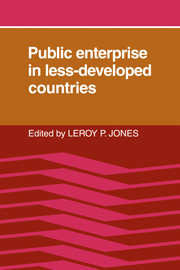Book contents
- Frontmatter
- Contents
- List of contributors
- List of figures and tables
- Preface
- 1 Introduction
- Part I Why public enterprise?
- Part II Principal-agent relationships: Who should control public enterprises?
- Part III How are decisions made in practice?
- 6 Comparing state enterprises across international boundaries: the Corporación Venezolana de Guayana and the Companhía Vale do Rio Doce
- 7 Decision structure, technological self-reliance, and public-enterprise performance
- 8 Labor–management conflict resolution in state-owned enterprises: a comparison of public- and private-sector practices in India
- Part IV How do public enterprises behave in international markets?
- Part V How does risk alter public-enterprise decisions?
- Part VI How are incentive structures to be designed?
- Part VII How does public enterprise compare with other intervention mechanisms in overcoming particular problems?
8 - Labor–management conflict resolution in state-owned enterprises: a comparison of public- and private-sector practices in India
Published online by Cambridge University Press: 04 August 2010
- Frontmatter
- Contents
- List of contributors
- List of figures and tables
- Preface
- 1 Introduction
- Part I Why public enterprise?
- Part II Principal-agent relationships: Who should control public enterprises?
- Part III How are decisions made in practice?
- 6 Comparing state enterprises across international boundaries: the Corporación Venezolana de Guayana and the Companhía Vale do Rio Doce
- 7 Decision structure, technological self-reliance, and public-enterprise performance
- 8 Labor–management conflict resolution in state-owned enterprises: a comparison of public- and private-sector practices in India
- Part IV How do public enterprises behave in international markets?
- Part V How does risk alter public-enterprise decisions?
- Part VI How are incentive structures to be designed?
- Part VII How does public enterprise compare with other intervention mechanisms in overcoming particular problems?
Summary
The contrasts between state-owned firms and private enterprises are nowhere more apparent than in the conduct of labor-management relations. Because public firms are governed by a mix of market and bureaucratic rules, managers of these firms must attempt to satisfy a more complex set of objectives with regard to labor. This chapter considers the impact of these combined market and political-bureaucratic forces on the resolution of labor-management conflicts. Does “publicness” affect the handling and outcome of industrial disputes? Do the mechanisms for resolving conflicts in public enterprises differ systematically from private-sector mechanisms? If so, which of these contrasts are common to all public firms and which result from unique sets of industry- or firm-specific forces? These questions are addressed here with reference to the Indian economy.
Public-enterprise managers often must meet standards of efficiency or profitability and simultaneously fulfill the broader social objectives of the firm. Cost-minimization pressures may require high levels of productivity and labor costs that compare favorably with those of efficient private firms. Social objectives of equity and worker welfare may require firms to act as “model employers,” providing above-average earnings, superior working conditions, and greater job security than most private employers. A public firm is also required to function constructively as an instrument of economic development policy, with objectives that may include the manipulation of wages and prices, either to subsidize particular intermediate or final outputs or to contribute to macroeconomic efforts toward wage and price restraint.
- Type
- Chapter
- Information
- Public Enterprise in Less Developed Countries , pp. 141 - 166Publisher: Cambridge University PressPrint publication year: 1982
- 2
- Cited by

